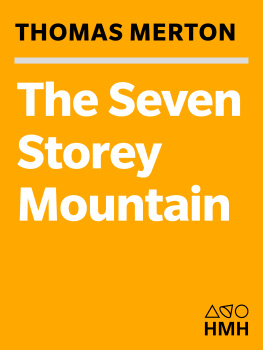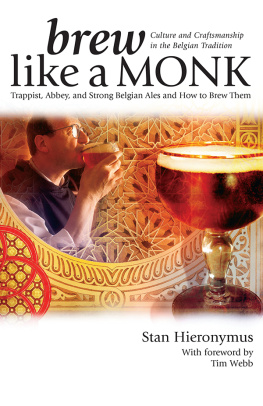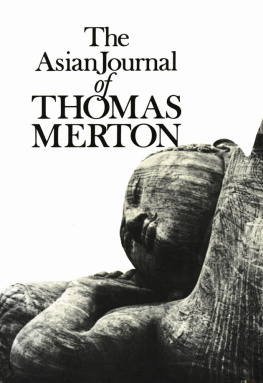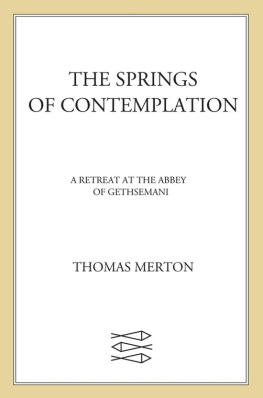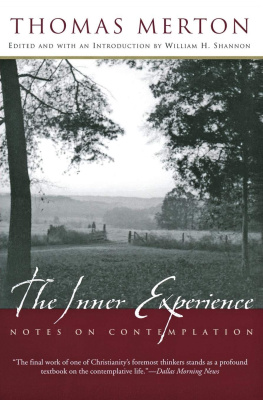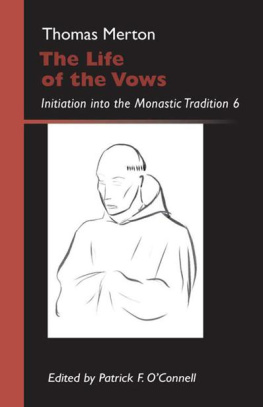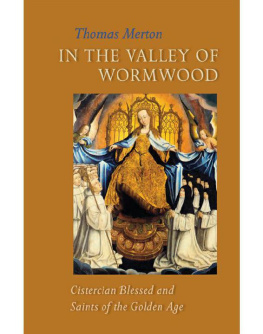Edited by Patrick Hart, O.C.S.O.
There is another side of Kanchenjunga and of every mountain-the side that has never been photographed and turned into postcards. That is the only side worth seeing.
In many ways the mountain has come to be identified with Thomas Merton, following The Seven Storey Mountain , his autobiography, which appeared fifty years ago. In none of Mertons writings have there been so many references to mountains as in this last volume of the journals, which we are calling The Other Side of the Mountain . Merton reflects on their extraordinary beauty and symbolism when in Alaska, but his most sustained writing on the subject occurs about a week after his meetings with the Dalai Lama, while making a retreat at the Mim Tea Plantation near Dharamsala. He recounts a dream he had on November 19, 1968: Last night I had a curious dream about Kanchenjunga. I was looking at the mountain and it was pure white, absolutely pure, especially the peaks that lie to the west. And I saw the pure beauty of their shape and outline, all in white. And I heard a voice sayingor got the idea of: There is another side to the mountain. Merton continues to reflect on this phenomenon in the same journal entry, realizing that he is seeing the mountain from the other side. He then takes more photographs of the mountain in the afternoon and concludes his thoughts with these memorable lines: The full beauty of the mountain is not seen until you too consent to the impossible paradox: it is and is not. When nothing more needs to be said, the smoke of ideas clears, the mountain is SEEN.
The seventh volume of Thomas Mertons journals has at least this much in common with the first volume, which I also edited-both were written from a variety of locations. Merton was traveling in his premonastic days (19391941), from New York to Cuba and back again to New York, then to St. Bonaventures at Olean, New York, with brief visits to the Trappist monasteries of Gethsemani and the Our Lady of the Valley in Rhode Island. During the period covered by this last volume, Merton had received permission to do some traveling. The five other volumes were written for the most part at Gethsemani and the journal was kept in a single ledger. When traveling, Merton used several notebooks and ledgers in keeping his journal. These in turn had to be checked against one another and the entries arranged in chronological order.
The first section, which we have titled The Election of a New Abbot, prepares the stage for what follows. During the last months of 1967 and the early weeks of 1968, Father Louis, as Merton was known in the monastery, was deeply concerned about the prospect of a new abbot after the resignation of Abbot James Fox. He feared the worst, and lest some should vote for him, he wrote a statement declaring his incompetence for the job and reminding the community that he had taken a private vow never to accept the abbatial office. He made it clear to all who consulted him that he was supporting Father Flavian Burns, who he felt would be sympathetic to his eremitical desires. Perhaps he also hoped that, as abbot, Father Flavian might be more open to some traveling, in contrast to the former abbot, who insisted that monks, and above all hermits, should not travel. Merton does not conceal his jubilation with the election of Abbot Flavian Bums.
It becomes apparent rather soon after the election of the new abbot that Merton is seriously thinking of some travel. Following a number of invitations, permission was given to visit two monasteries in May. He kept a special notebook for his journal entries during the few weeks he spent at these two monasteries, the first a rather primitive Benedictine monastery, the Monastery of Christ in the Desert in Abiquiu, New Mexico, not far from the studio of Georgia OKeeffe, and the second a newly founded Cistercian (Trappistine) monastery, Our Lady of the Redwoods, in northern California. Merton later transcribed parts of this journal and had it typed up with the idea of publishing a small book on the experience. Although this was not published until after his death, it did appear under the title he had chosen: Woods, Shore, Desert .
Even before his time away from Gethsemani visiting New Mexico and California in May 1968, he had received a pressing invitation to attend a meeting of monastic superiors of the Far East in Bangkok, Thailand, in December. He presented the invitation to the abbot, who spent some time in consultation and discernment before responding. After several months of waiting and additional letters from people like Dom Jean Leclercq urging Merton to come, the abbot finally gave Father Louis permission to spend six months in the Far East, not only attending the meeting in Bangkok, but giving retreats at a couple of Cistercian monasteries in Indonesia and Hong Kong. Above all Merton was very interested in making contact with various Buddhist monasteries in India, especially the Tibetan Buddhists in exile at Dharamsala. He felt this would be an ideal time to learn from the wisdom of the East by actually meeting the monks in their own monasteries.
Not having any recent experience in preparing for travel, Merton had much to learn about obtaining a passport, securing visas, getting vaccinations, and shopping for proper clothing for travel. He especially wanted a jacket with many pockets for his notebooks, address books, and film for his camera. He found it all challenging, and it seemed to revive his youthful spirits. He was like a child going to the circus. During his time of preparation for the trip to the Far East, he sought out contacts from various persons he knew. Dom Aelred Graham, for example, put Merton in touch with Harold Talbott, who in turn arranged for some meetings with the Dalai Lama. His Friend Amiya Chakravarty introduced him to some of his lama Friends in India and was actually present in India during Mertons pilgrimage.
Several weeks before his departure for Asia, he made a brief trip to Washington to meet with the people at the Indonesian embassy, where they discussed Java, mysticism, and what awaited him in the Far East. After Ron and Sally Seitz met his plane on the return flight, there was another dinner, this time at the Embassy Club; Merton then returned with Fr. John Loftus to St. Bonaventure Hall at Bellarmine College, where he spent the night with the Franciscan friars.
His entry of August 26 about that evening is classic in his enthusiasm for one American ritual-football. The Packers beat the Dallas Cowboys and, as Merton comments, it was damn good football. Merton then waxes exuberant: Football is one of the really valid and deep American rituals. It has a religious seriousness which American religion can never achieve. A comic, contemplative dynamism, a gratuity, a movement From play to play, a definitiveness that responds to some deep need, a religious need, a sense of meaning that is at once final and provisional: a substratum of dependable regularity, continuity, and an ever renewed variety, openness to new possibilities, new chances. It happens. It is done. I was completely surprised by Mertons eloquence on Americas favorite sport.
As the days drew closer to the time of his departure, he was busy cleaning his hermitage, discarding old letters and papers, and sending books and manuscripts to the Merton Center at Bellarmine College for safekeeping. Fr. Daniel Walsh, who taught philosophy at both Gethsemani and Bellarmine, was usually the one who delivered the books to the Merton Center. Before leaving he also gave Fr. Walsh a copy of an unpublished manuscript he had been revising, The Inner Experience it was eventually published in Cistercian Studies serially over a period of two years (19831984). He asked Fr. Walsh to read the manuscript while he was in the Far East and report back to him on his return as to the feasibility of its publication. In 1967 he had made it clear in his Trust document that it should not be published as a book , but could be shown to scholars. Although the manuscript was never published as a book, it is available in offprints from Cistercian Studies .

![Trappists The other side of the mountain: the end of the journey ; [1967-1968]](/uploads/posts/book/253886/thumbs/trappists-the-other-side-of-the-mountain-the-end.jpg)
